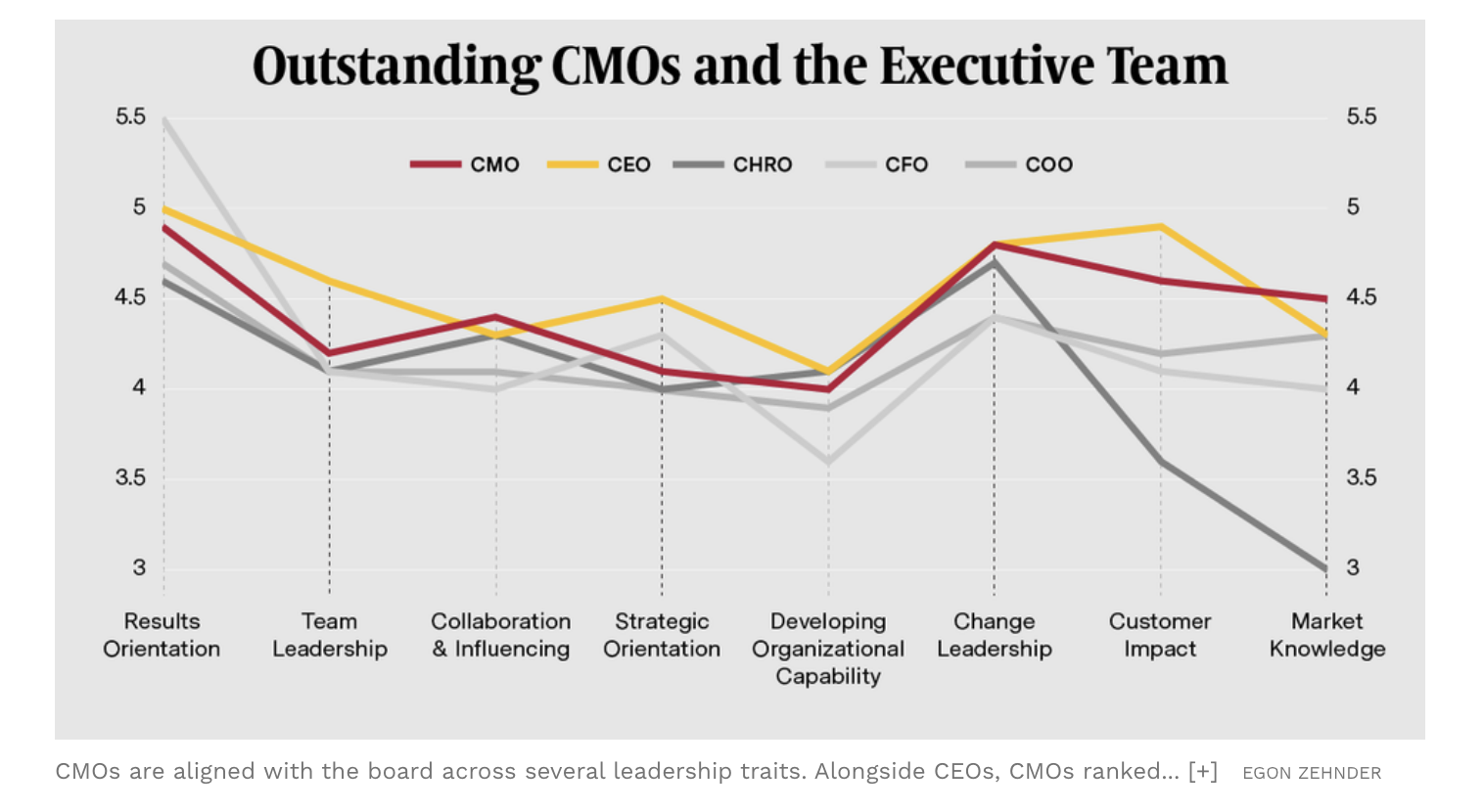Once upon a time, everyone turned to CMOs to become champions for the brand for advertising, brand management, and market research. But today’s emerging technologies have pushed CMOs to wear new hats and take on a more blended role across IT, sales, and finance.
Insight: Today’s CMOs are facing a crossroad that points to the expansion of different roles and a new dedicated focus on customer experience and growth in the new year.
Data: Accenture reports that 90% of organisations believe the CMO to be the connective tissue between different lines of the organisation.
What’s the step change: CMOs need to adopt new skills that allow them to create more value for customers and use new technologies to transform the customer experience.
According to Kristi Maynor from the CEO Network, CMOs are most aligned with the board across several leadership traits. Alongside CEOs, CMOs ranked highest at team leadership, collaboration and influencing, change leadership, customer impact, and market knowledge.

Image credits: Forbes
Now, more than ever, businesses are not just turning to CMOs to build brands — businesses also look to them to drive growth, take the lead in digital transformation initiatives, manage customer expectations, all while managing limited marketing budgets.
New Pillars of Customer Experience Management
CMOs of the future have bigger roles to play and will be essential to shaping the customer journey on top of helping drive growth for the business, accommodating new innovations in digital, and developing better customer experiences.
More importantly, they need to be the voice of the customer, which entails learning about new trends, conducting market research, and understanding customer preferences.
By focusing on how they can improve the customer experience, they can take an active role in driving the digital transformation of their companies and push for growth.
They will need to become the new pillars of customer engagement and help shape their organisation’s architecture for a more customer-centric experience.
They will also be required to take a more proactive approach to understanding the needs of the customers, shaping the business model to support the customer engagement agenda, and exploring new paths for growth.
Embracing Digital & Data-Driven Creativity
To be future-ready, CMOs need to be more data-driven. Having a thirst for data and understanding the changing customer behaviour is crucial to shaping the overall customer experience for the better. But that is not all there is. Creativity needs to be added to the mix for marketing to be truly effective.
According to CMO.com, “Today’s CMOs must have a growth mindset, be agile, and push the boundaries of innovation. This means celebrating risk-taking — whether it’s with new channels, partnerships, or experiences — and instituting a culture of testing where you can constantly iterate on and improve the customer experience.”
To deliver data-driven customer insights, they need to collaborate with the CIOs better. Moving forward, CMOs and CIOs need to see the importance of their strategic partnership. CMOs know the ever-increasing importance of big data, analytics, and secure technology — all of which the CIO acts as the chief gatekeeper.
Cross-Functional Team Collaborations
Cross-functional teams bring together individuals from different functions or divisions within a company. This can be in marketing, sales, finance, creative, digital, strategy, or many others. With their combined skills and experience, cross-functional teams are far better able to collaborate and work towards their goals.
Although they are usually created for short-term projects and campaigns, many customer-centric organisations are getting reorganised into cross-functional teams to focus on understanding the customer’s needs and being able to answer it across the customer journey.
Cross-functional team structures correspond to better revenue growth. And CMOs looking to drive growth for the companies need to think about how they can implement it across their teams this year.
According to Salesforce, two in three CMOs say they’ve already reorganised their teams to focus on the customer journey.
This is because cross-functional teams are far better able to:
- Understand their clients and customers and respond as needed
- Develop structures that are tailored to the needs of their customers rather than internal products and services
- Have in-house agencies used for marketing/advertising strategy and account management
- Develop and invest in talent
In Conclusion
The road to success for CMOs is in data-driven creativity and helping the organisation better understand the needs of its customers. This includes working closely with different parts of the organisation to build customer loyalty and drive better engagement.
They will have to be comfortable wearing different hats in branding, communications, sales, customer experience, and emerging tech — always drive for innovation and a better CX that customers will keep coming back for.
CMOs of the future need not only be adaptive to change, they also need to be champions for better customer experience and always push for growth. Being better aligned on goals with key stakeholders while always putting the needs of the customer to heart is the key to success for CMOs in their new diversified roles.
At Step Change, our shared vision of business results come first. This is supported by a marketing strategy that is aligned with your goals from acquisition to customer experience and retention across all touchpoints.
We believe that customer-centricity and digital transformation are central to delivering better customer experiences. To drive growth, building a brand entails using different tactics that are relevant today. At Step Change, strategy meets creativity and tech.
If you’re curious to find out more information on how you can unlock your brand’s full potential, contact us today.
PS. In case you haven’t heard, our business is expanding and joining forces with The Zoo Republic. Read about the good news here.







![#KatieTalks to Step Change’s Robert Steers [PODCAST]](https://blog.hellostepchange.com/hubfs/BLOG/Posts/5-Connection/katie-talks-robert-steers.001.jpeg)






